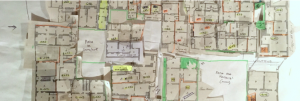NEWS Major Project Aims at Reconstructing Florentine Ghetto
 By Pagine Ebraiche Staff
By Pagine Ebraiche Staff
A major research project aiming at reconstructing the geo-economic and social physiognomy of the Florentine ghetto is due to be completed in March.
The “Ghetto Mapping Project” is being carried out by the Medici Archive Project and coordinated by the director of the Eugene Grant Research Program on Jewish History and Culture in Early Modern Europe, Gabriele Mancuso.
The ghetto of Florence was established in 1570 by Cosimo I, the first grand duke of Florence, near the area of Mercato Vecchio (Old Market). Its’ location, in the very center of the city, entailed a number of legal and logistical problems.
“While officially erected to gather all the Jews of the Grand Duchy and conform to the principles of the Counter-Reform Church, the ghetto of Florence was in fact the product of a very well planned private real estate investment of the Medici family. As explicitly affirmed by the five magistrates commission whom Cosimo I had appointed to conduct a detailed survey of all the Jewish population in Tuscany as a preliminary phase of the construction of the ghetto, confining the Jews in a small and overcrowded area, and banning them from any real productive activity, would have soon forced its residents to ask for a number of services that the state could provide upon payment of lavish fees. The ghetto of Florence to sum up, was not only the expression and result of widespread and substantially omnipresent anti-Jewish feeling but also the product of a major, very rewarding investment plan,” explains the introduction to the project on its’ website.
The project seeks to achieve a virtual reconstruction of all the ghetto spaces, as well as to focus and gather more information on ghetto economies, demography and history.
“The relevance of this initiative lies in its potential to unearth a body of knowledge which has been buried for centuries in Italian archives. Our challenge it to bring this piece of Jewish heritage back to life,” commented Mancuso.
